Pumpkins are members of the Cucurbita genus, a vine plant group that includes Pumpkins and other plants such as Cantaloupe, Summer Squash, Watermelon, Winter Squash, Zucchini, and Gourd. Pumpkin is a warm-season crop that can be grown in most states of the USA. All USA states produce some Pumpkins, but six states produce most of them. About 40% of the Pumpkin acreage was planted in the top 6 Pumpkin-producing states in the USA.
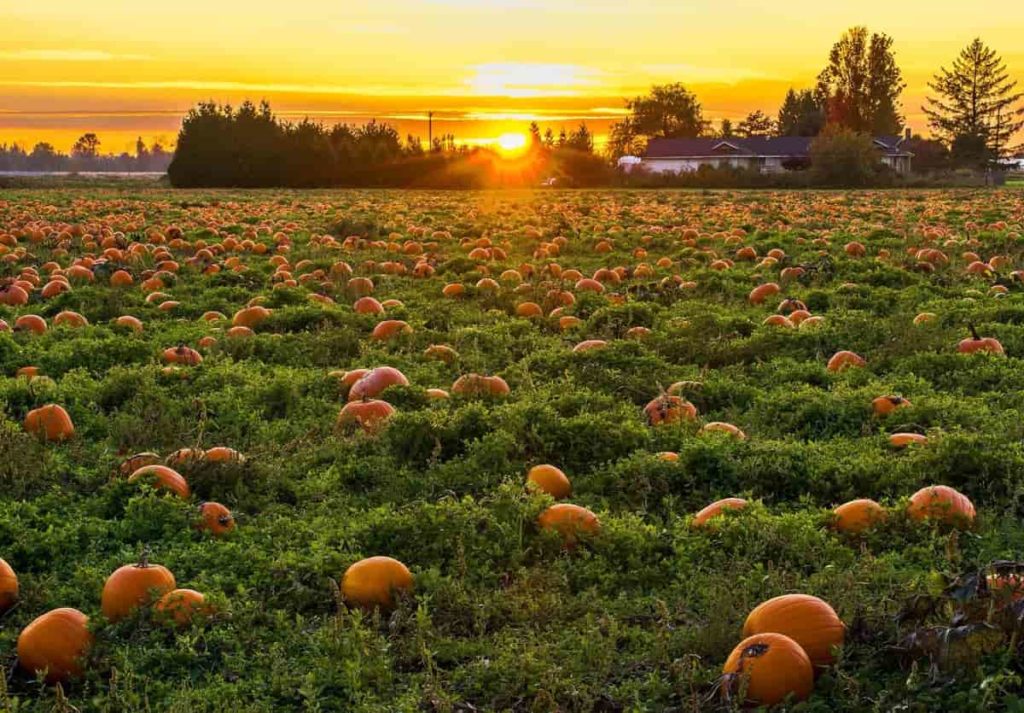
Growing Pumpkins from the ground improves air circulation around the plants, which reduces fungal diseases and makes plants less susceptible to pests when they are above ground. Pumpkins grown vertically are easier to harvest because you have better access to the Pumpkin plants. Illinois expanded its area and leading position, growing more than twice as many Pumpkins per acre as the other highland states on 15,900 acres. California, Indiana, Michigan, Texas, and Virginia each planted between 3,700 and 6,000 acres.
How to start Pumpkin farming in the USA
Major Pumpkin producing states in the USA
Texas is a major Pumpkin-producing state. American farmers are celebrating a big Pumpkin crop this year due to the dry weather and are seeing an increase in demand throughout the year with the help of new avenues of growth in products such as flavored coffee and pet food. The USA produces more than 1.5 billion pounds of Pumpkins each year. The top Pumpkin-growing states in the USA are Illinois, Indiana, Ohio, Pennsylvania, and California.
Illinois has the largest area of Pumpkin in all states and the largest acre of processing. About 80 percent of the Pumpkin acre in Illinois is set aside for pie filling or other processing use, compared to about 3 percent in Michigan and even more in California and Virginia. This difference in the type of Pumpkin commonly grown in Illinois helps to explain the difference in production and price between Illinois and other higher states.
About 80% of the American Pumpkin crop is available during October. Out of a total of 1.5 billion pounds, more than 800 million Pumpkins are ripe for picking in one month of the year. According to the University of Illinois, 95% of Pumpkins grown in the United States are harvested in Illinois soil. Based on the Illinois Department of Agriculture, 95% of the US crop produced for processing is grown in Illinois.
In case you missed it: Top 17 Steps/Ways to Boost Pumpkin Yield: How to Increase Production, Size, and Quality
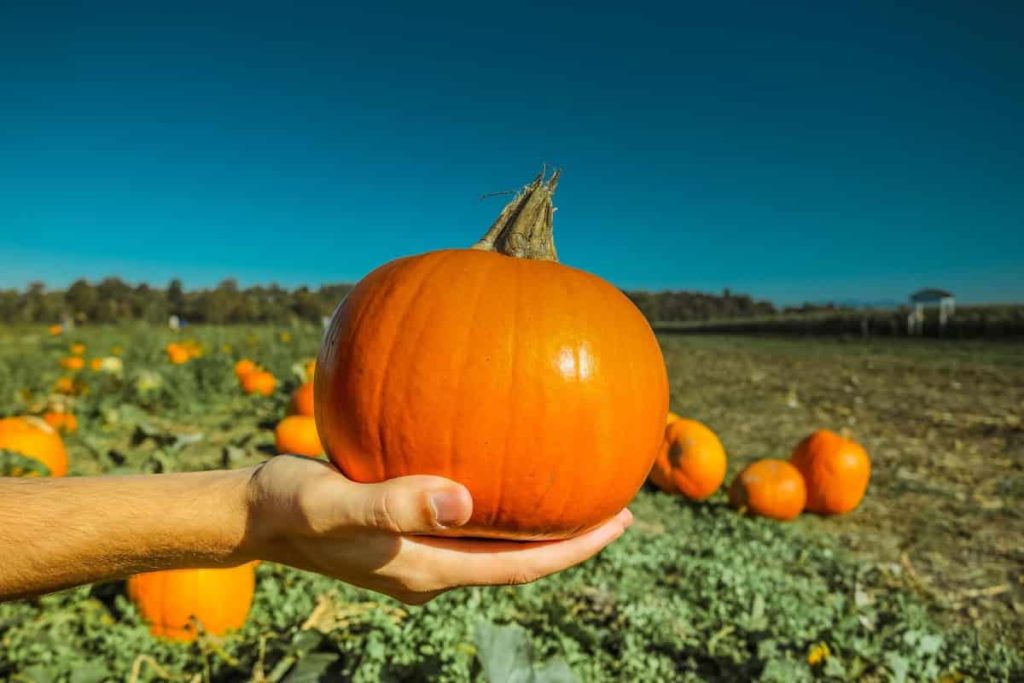
Soil and location for Pumpkin farming in the USA
You should choose the sunny part of your garden, if you have it, a slight inclination to the south is also good. Give your Pumpkin patches plenty of space, and prepare your bed in early March / April for planting in May / June. To make a soil bed for Pumpkins, choose the size of the area you will prepare (keeping in mind the Pumpkin plants will require a lot of space, the vines can run 25 feet or more).
Then dig two to three feet down and backfill with a full fertilizer and a mixture of fertilizers. When backfilling, do not compact the soil and avoid areas where vine crops have been grown. Pay attention to the area around the patch where your Pumpkin vines grow and enrich. Pumpkin vines will lower the roots, and good soil outside the bed will result in better Pumpkins. Many Pumpkin growers have kept many secrets when it comes to composting.
If in doubt, ask your greenhouse what works best for your soil conditions and the type you plan to grow. Pumpkins perform well in pH-neutral soils between 6.00 and 6.5; a soil test will tell if your soil needs to work. Choose a place where the vines have enough space to ramble. When the plants are young, you can direct the vines where they want to go. However, once they are established and begin to flower, the vines should be left alone.
Where to plant Pumpkins in the USA
Pumpkins are heat-loving plants, so choose a place with plenty of sunlight. Place the seeds you are planting according to the recommendations on the seed packet. To increase their success, consider growing seeds in hills of dirt slightly higher than the ground. Hills usually heat up much faster than flat land. They also draw water very fast. Planting in the hills will also allow the oxen to flow downhill.
Plant spacing and depth for Pumpkin farming in the USA
Pumpkin vining requires at least 50 to 100 square feet per hill. Plant the seeds one inch deep (four or five per hill). Keep a distance of 5 to 6 feet between the hills, 10 to 15 feet apart in rows. Varieties of semi-bush 1 inch deep (four or five seeds per hill) and the thinnest best two plants per hill. Allow plants about 4 feet between hills and 8 feet between rows.
In case you missed it: Organic Pumpkin Farming, Cultivation Practices
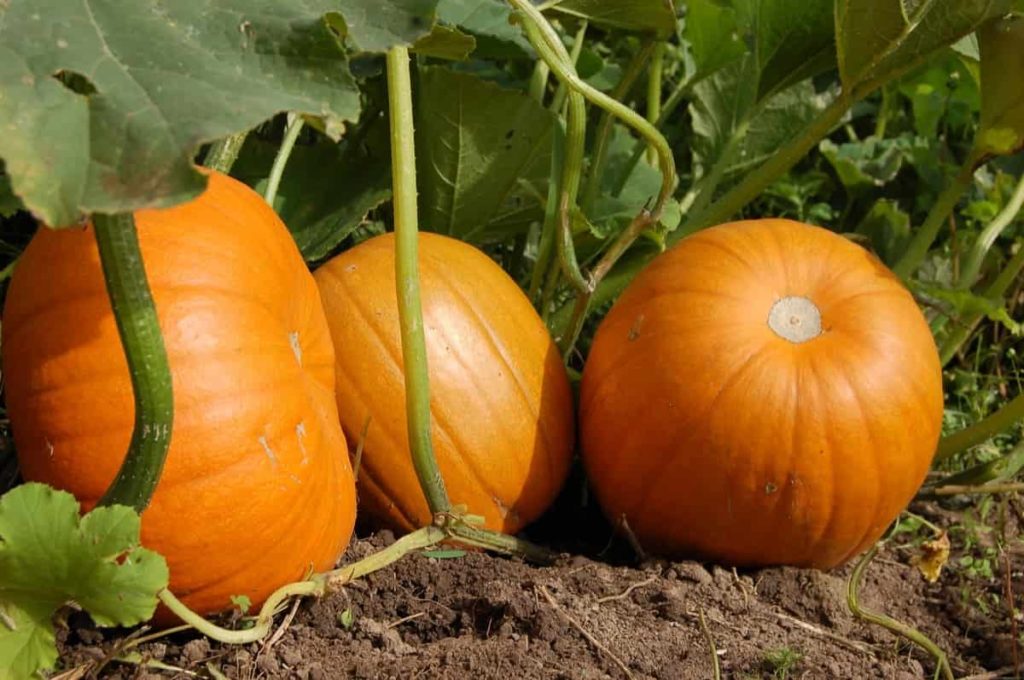
Plant two or three seeds of the smaller variety at a depth of one inch every 2 feet. The rows must be 6 to 8 feet apart, and when they have the first true leaves, thin the best plant every 2 feet. Plant bush varieties are one inch deep (1 or 2 seeds per row of feet) and thinner than one plant every 3 feet. Then, allow 4 to 6 feet between rows.
Seed selection tips for Pumpkin farming in the USA
All you want to do is select the Pumpkin varieties you want. Some types are better to eat, some to cut, and others to grow the monster Pumpkin that can win you the competition. Start with standard seeds, and you will have a better chance of growing standard Pumpkins.
Pumpkin varieties available in the USA
More than 250 varieties of Pumpkins are readily available in North America alone. Two types of Pumpkins have become the biggest money makers. Ornamental Pumpkins, also called Halloween Pumpkins, are the most common. They are round, bright orange, and smooth and are usually carved or used as decorations for Halloween.
The second type is processing Pumpkin, which is gray, long, and tasty on the outside. They typically end up in processing plants, where the Pumpkin flesh is canned and shipped to supermarkets, which sell it for making pies and other Pumpkin-related dishes.
Blue Lakota – This heirloom species of Pumpkin belongs to the Midwestern United States. These Pumpkins have light blue-green skins and slight ribbing. They have the shape of a flat ball and reach a point in the stem.
Conditions for Pumpkin Farming in the USA
Pumpkin is a warm-season crop that is usually planted in early July. The specific conditions required for growing Pumpkins require that the soil temperature be at least 15.5°C and 8 cm (3 inches) deep and that the soil retains water well. Pumpkin crops can be damaged if there is a lack of water or cold temperatures, in this case, less than 18°C.
In case you missed it: Pumpkin Farming in Polyhouse (Gummadikaya) for Profit
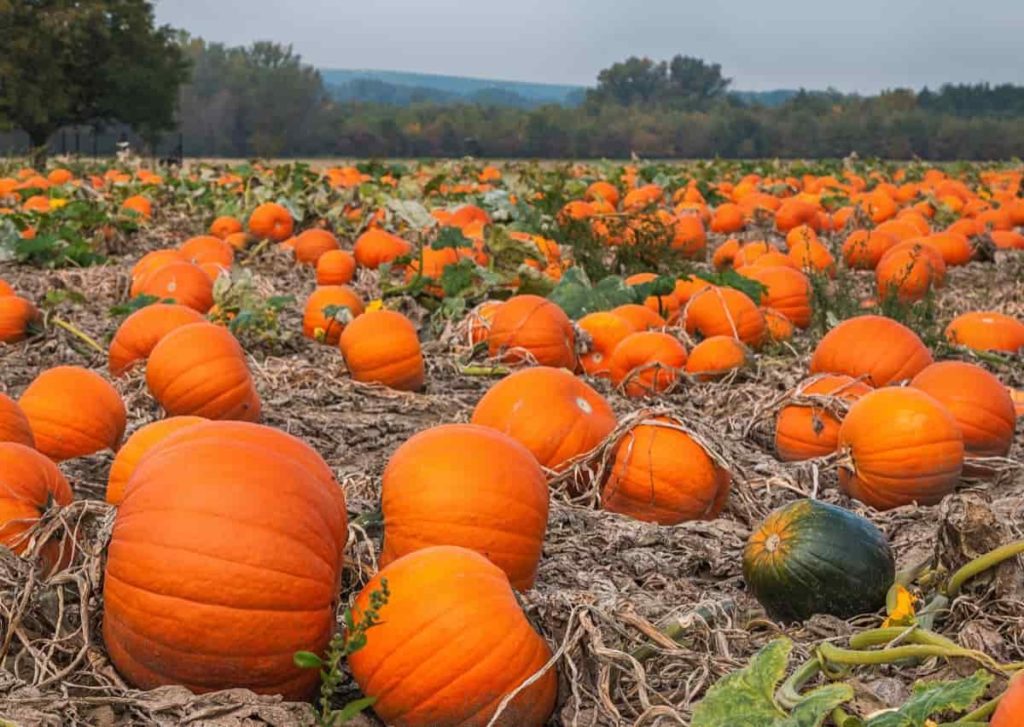
How to grow Pumpkins vertically
- Pumpkin plants do not tolerate frost, so it is best to wait until the last frost has passed and the soil warms up before planting.
- Prepare the soil by digging some rich manure or well-broken manure in the soil.
- Plant Pumpkin seeds about an inch (2.5 cm) deep at the base of your chosen structure and leave at least 12 inches (30 cm) between Pumpkin seeds.
- You should see that the seeds start germinating in about a week.
- Pumpkin plants produce long branches called tendrils that help to wrap around the trellis and other vertical structures.
- As the Pumpkin plants begin to grow, you can help them by wrapping tendrils around the trellis. As soon as the Pumpkins appear, you can make an old piece of cloth for the trails and make a hammock to support their weight so that the Pumpkins can rest on it.
Soil that is sandy with a lack of water or poorly drained soil that fills up with water after heavy rains is detrimental. Pumpkins, however, are pretty hardy, and even if many of the vine’s leaves and parts are damaged, the plant can quickly grow secondary vines to replace what has been removed.
Pumpkin season in the USA
Most states have seasonality in the fall months. The three largest producers in the United States are Illinois, Indiana, and Ohio. The longest Pumpkin season in Illinois is from August to November. The Pumpkin season in Indiana is one month long in September and October, and in Ohio until November.
Pumpkins have a long growing season of 75 to 100 days, so you must plant them in most places from mid-spring to late. Sow Pumpkin seeds in late April or early May; they will be ready for harvest sometime in August. Pumpkins are used in the USA as decorations for autumn holidays such as Halloween and Thanksgiving. Pumpkins can be used for table or front porch arrangements, carved, or cooking.
Pumpkin season in different states in the USA
| State | Pumpkin in season |
| Alabama | mid-September till mid-November |
| Alaska | September and October |
| Arizona | September and October |
| Arkansas | September till mid-November |
| California | September till November |
| Colorado | September and October |
| Connecticut | mid-September till November |
| Delaware | August till November |
| Florida | September till November |
Water and care for your Pumpkin plants
Most vegetable crops need deep but soft soaking once a week – about an inch of water at a time. Adjust based on rainfall accordingly. Pumpkin leaves appear wilted in the afternoon heat, even if the soil is still moist. If the plants benefit again in the evening or under a cloud cover, resist the urge to remove even more dirt, as more water can help the roots rot. Mulching your beds will help keep plants more permanently hydrated and will also help eliminate weeds.
Generally, you do not need to harvest your vines. Larger leaves help them produce more carbohydrates, which means more Pumpkins. Pumpkin plants should be cultivated with hoe and shallow and kept free from weeds. If the drought lasts longer in early summer, irrigate. Pumpkins tolerate short periods of hot and dry weather well. Pumpkins should be given deep but light water once a week. Water the plants about 1 inch at a time. However, adjust your water according to the rainfall in your area.
If Pumpkins are given too much water, they will rot. Remember that most Pumpkin leaves will wither in the heat of the day, even when their soil is still moist. You don’t need to water much until the leaves reappear when the heat fades, or the sun goes down under the clouds. Applying mulch to your beds will help retain moisture in the soil. In addition, mulch will help keep weeds that can suck water from your plants. When watering your Pumpkins, keep the plants as dry as possible unless it is a very dry, sunny day.
Dampness can cause rot and promote disease. Bees can be killed by pesticides, which are essential for pollinating squash and Pumpkins. When pesticides are used, they should be applied only in the late afternoon or early evening when the flowers are closed for the day and the bees no longer come to the flowers. Because new flowers bloom every day and bees land only inside open flowers, these pollinating insects are protected from contact with any potentially deadly spray.
In case you missed it: Pumpkin Farming, Planting, Care, and Harvesting
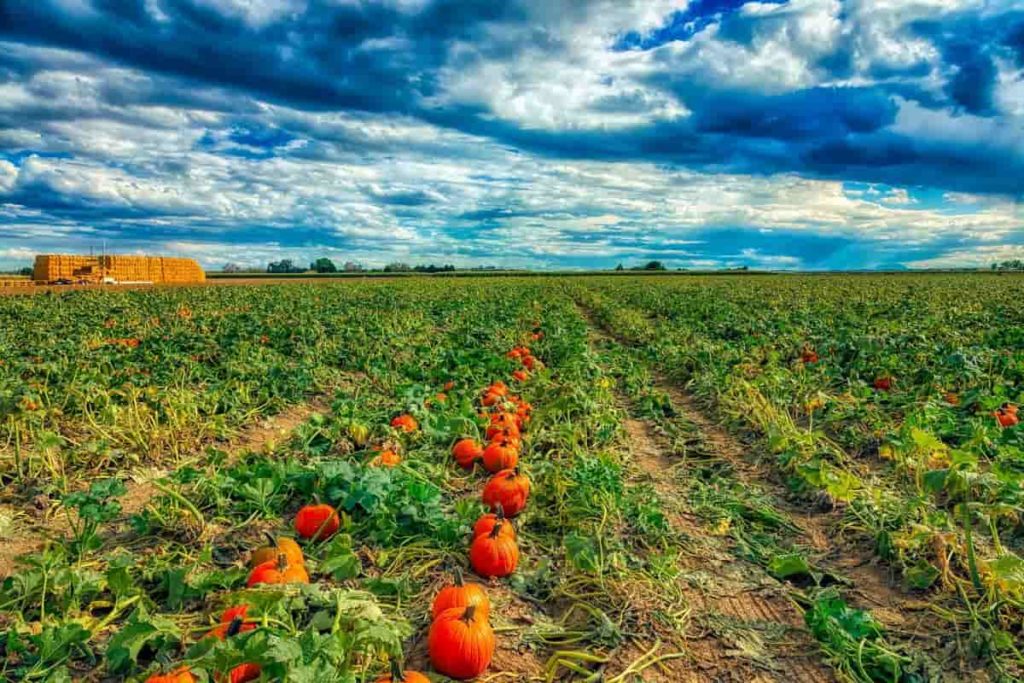
Fertilizer requirement for Pumpkin growth
Pumpkins are heavy feeders. Using vegetable garden fertilizer can provide them with the right food. Test the soil every two years for growing Pumpkins. The results will determine what type of dirt you are dealing with – including pH and nutrient levels – and then help you plan accordingly.
How to pollinate Pumpkins
Pumpkins produce both male and female flowers, usually fertilized by bees. Pumpkins have been pollinated in the United States by the local squash bee, Peponapis pruinosa. Still, the bee has declined, perhaps partly due to sensitivity to the pesticide. Ground-based bees like squash bees and the eastern bumblebee are better suited for selling honey bees produced from Pumpkin pollen.
About one hive per acre (0.4 hectares, or five hives per 2 hectares) is recommended for Pumpkin farming by the US Department of Agriculture. If bees are not enough for pollination, gardeners may have to pollinate by hand. Inadequate pollen Pumpkins usually start to grow but fail to grow.
Insects and Disease Problems in Pumpkin Farming
Insects can severely damage your ability to grow Pumpkins. However, before using pesticides, remember that you need pests to pollinate your crop. Watch out for diseases like Cucumber Beetles, Melon Aphids, Pickleworms, Spider mites, Squash Beetles, Squash bugs, and Squash vine borers. Many bacterial and fungal diseases attack cucurbits. The common diseases in your Pumpkin patch are bacterial wilt and powdery mildew.
Pumpkin varieties are affected by almost the same diseases and pests that infect Zucchini; however, they are highly resistant. In particular, Pumpkins are attacked by mullet and chrysanthemum insects that form honeycombs on Pumpkin plants, squirrels that dry the leaves, and mildew fungus that produces white spots on the leaves.
To protect Pumpkins, we avoid planting dense plants, thus reducing the risk of fungal and entomological diseases. When the temperature is below 30°C, shake the roots around the plants while the Pumpkin plants are mixed with a tablespoon of green soap and a teaspoon of a liter of water every two weeks with an eco-friendly solution.
Pumpkin production in the USA
According to the USDA National Agricultural Statistics Service, approximately 66,200 acres of Pumpkins were harvested in the United States, producing more than 1.5 billion pounds of usable Pumpkins with a total production of more than 2 billion. The top nine states (Illinois, Pennsylvania, New York, Indiana, Michigan, California, Ohio, North Carolina, and Texas) produced about 75% of it.
In case you missed it: Brackish Water Aquaculture, System, Benefits
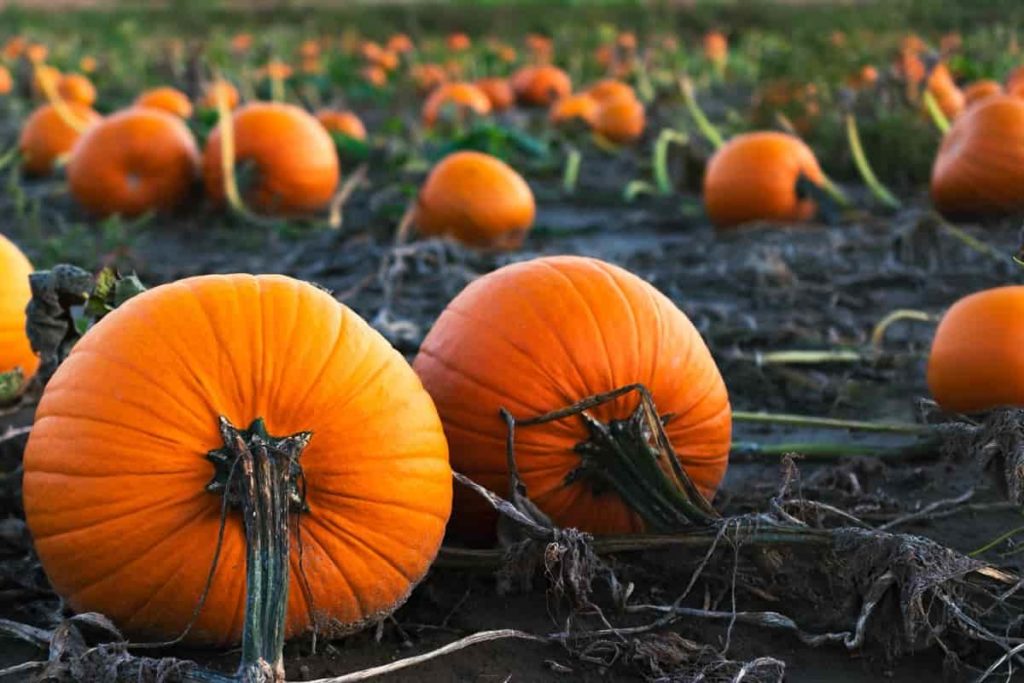
About 15% of the Pumpkin area is used to make processed Pumpkin products. Illinois remains the leading producer of processed Pumpkins, together with the other five leading states, and produces about half of the national total.
How much profit can a Pumpkin farm make?
On average, a small Pumpkin farm can earn about ً $30,000 a year. Profits vary greatly, however, because all forms are different sizes.
Pounds of Pumpkins per acre in the USA
The density of Pumpkins per acre varies from state to state. Illinois grows an average of about 40,000 pounds per acre, California and Texas grow about 30,000 pounds per acre, and Indiana, Michigan, and Virginia grow about 20,000 pounds per acre.
Illinois grows three and a half times more Pumpkins than the next most productive state. Illinois produced 420 million pounds of Pumpkins. California and Indiana produced about 120 million pounds of Pumpkins, Virginia produced about 90 million pounds, and Michigan about 80 million pounds.
Conclusion
Pumpkin production is widespread throughout the United States, with crop conditions varying from region to region. Pumpkin is the most popular crop in the USA, producing more than 680 million kilograms (1.5 billion pounds) of Pumpkins.
- Economical Aquaculture: A Guide to Low-Budget Fish Farming
- 15 Common Planting Errors That Can Doom Your Fruit Trees
- How to Make Houseplants Bushy: Effective Tips and Ideas
- Innovative Strategies for Boosting Coconut Pollination and Yield
- Pollination Strategies for Maximum Pumpkin Yield
- The Complete Guide to Chicken Fattening: Strategies for Maximum Growth
- Natural Solutions for Tulip Problems: 100% Effective Remedies for Leaf and Bulb-Related Issues
- Revolutionizing Citrus Preservation: Towards a Healthier, Greener Future
- Natural Solutions for Peony Leaf and Flower Problems: 100% Effective Remedies
- Maximizing Profits with Avocado Contract Farming in India: A Comprehensive Guide
- Natural Solutions for Hydrangea Problems: 100% Effective Remedies for Leaf and Flowers
- The Ultimate Guide to Choosing the Perfect Foliage Friend: Bringing Life Indoors
- From Sunlight to Sustainability: 15 Ways to Use Solar Technology in Agriculture
- The Ultimate Guide to Dong Tao Chicken: Exploring from History to Raising
- The Eco-Friendly Makeover: How to Convert Your Unused Swimming Pool into a Fish Pond
- Mastering the Art of Delaware Chicken Farming: Essentials for Healthy Backyard Flocks
- 20 Best Homemade Fertilizers for Money Plant: DIY Recipes and Application Methods
- How to Craft a Comprehensive Free-Range Chicken Farming Business Plan
- Brighten Your Flock: Raising Easter Egger Chickens for Beauty and Bounty
- How to Optimize Your Poultry Egg Farm Business Plan with These Strategies
- Subsidy for Spirulina Cultivation: How Indian Government Schemes Encouraging Spirulina Farmers
- Ultimate Guide to Raising Dominique Chickens: Breeding, Feeding, Egg-Production, and Care
- Mastering the Art of Raising Jersey Giant Chickens: Care, Feeding, and More
- Ultimate Guide to Raising Legbar Chickens: Breeding, Farming Practices, Diet, Egg-Production
- How to Raise Welsummer Chickens: A Comprehensive Guide for Beginners
- How to Protect Indoor Plants in Winter: A Comprehensive Guide
- Ultimate Guide to Grow Bag Gardening: Tips, Tricks, and Planting Ideas for Urban Gardeners
- Guide to Lotus Cultivation: How to Propagate, Plant, Grow, Care, Cost, and Profit
- Agriculture Drone Subsidy Scheme: Government Kisan Subsidy, License, and How to Apply Online
- Ultimate Guide to Raising Araucana Chickens: Breed Profile, Farming Economics, Diet, and Care
- Bringing Hydroponics to Classroom: Importance, Benefits of Learning for School Students
- Ultimate Guide to Raising Polish Chickens: Breed Profile, Farming Economics, Diet, and Care
- Ultimate Guide to Raising Australorp Chickens: Profile, Farming Economics, Egg Production, Diet, and Care
- Silkie Chicken Farming: Raising Practices, Varieties, Egg Production, Diet, and Care
- Sussex Chicken Farming: Raising Practices, Varieties, Egg Production, Diet and Care
- Homemade Feed Formulations for Livestock: Discover Cost-effective Starter to Finisher Feed Recipes